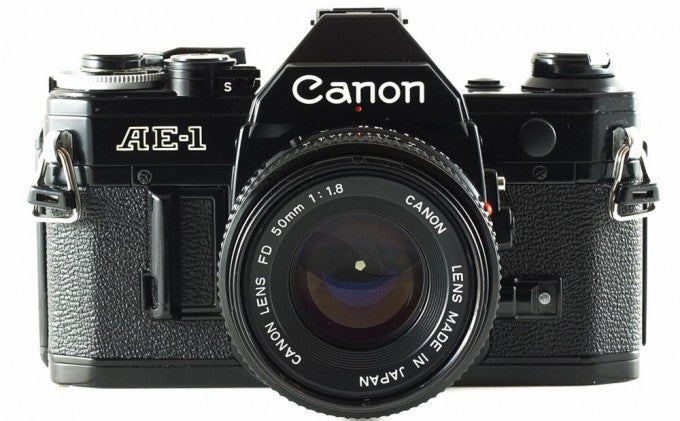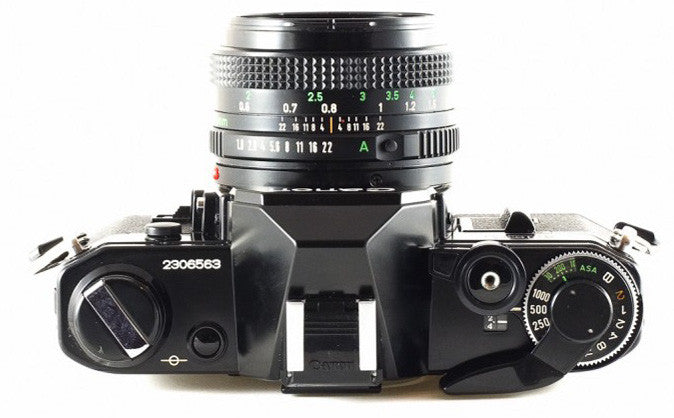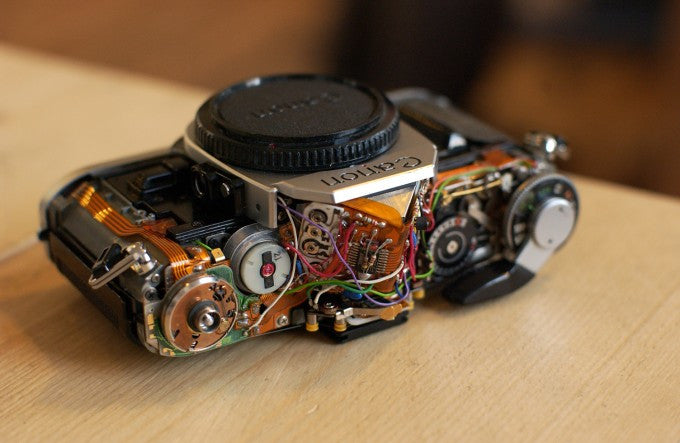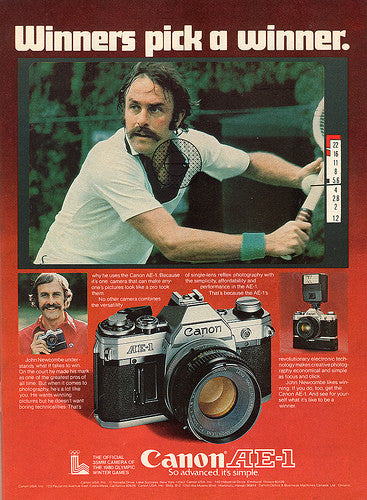Intro:
Canon’s AE-1, released in 1976, and the subsequent AE-1 Program, released in 1981, are cult classics in the crowded SLR market. Touted as the world’s first camera equipped with a microprocessor, it gave photographers the option to use Shutter Speed Priority exposure mode, rather than the usual Aperture Priority offered by their main competitors. They were a runaway success, and are still a very popular choice on the used market today.
The major difference between the older AE-1 and the AE-1 Program (AE-1P), is that the Program additonally features fully automatic exposure, which chooses both the aperture and shutter speed by itself. There were a couple of little cosmetic changes, and ergonomic changes – but nothing to lose sleep over. The main difference is the exposure modes.

A few good bits
Like Bruce Willis or Rambo – the AE-1 can take a pounding and keep on shooting. Despite the chrome finish being quite easily scratched and roughed up (especially on the black paint ones) we’ve seen some really battered examples that keep on working like champs after quite a few scrapes. Hewn from metal, they’ll take a lot of stick before they give up the ghost.
Shutter speed priority is a great feature – you’ll always know how long the exposure will be, and can therefore anticipate sharp photos every time – or acheive a consistent level of motion blur. On Av cameras – it can be easy to overlook the camera automatically setting a lower shutter speed than you were expecting and that winning shot becomes a blurry mess.
The viewfinder is quite big and bright, with a split screen focusing aid. It’s much better than most of todays lower priced DSLR cameras, which are puny in comparison. There’s an exposure indicator on the right hand side of the viewfinder to let you know what the aperture is.
They’re also pretty snazzy – their retro SLR shape, in silver or professional black is complemented by Canon’s old-style logo engraved on the pentaprism.
The price is also pretty reasonable, with collectors and serious enthusiasts going for the A1 and F1 models over the more common AE-1s. You can expect to pay about £60-70 for a good used example with standard 50mm lens. Lenses themselves are also fairly cheap, as they are not a popular choice to adapt to modern cameras – you can pick up a 50mm f1.4 for around £70, or a 28mm for about £40. There’s also a wide system of accessories to choose from.

A few bad bits
Ouch. Apparently Canon’s engineers only held the camera for a couple of seconds at a time. The AE-1 does not seem to be designed for most hands. Quite angular, it’s difficult to get a good grip if your hands are not perfectly average ergonomically. The AE-1 is not very comfy to hold for an extended period of time. Granted, most classic cameras from this period are awkward to pick up. It’s not so bad if you have the little accessory grip or motor drive fitted – or if you plan on using it for short periods.
Poor lens versatility. We said earlier that FD lenses are cheaper than their Nikon or Olympus counterparts, because they are not easily adapted to modern cameras. This is because to use them with Canon or Nikon (or any other) DSLRs, the adapter needs a corrective glass element which tends to ruin the quality. This lowers demand, which lowers price for those on the lookout. This was probably because when Canon released the current EOS mount in 1989, they wanted people to buy all their new lenses, so they made the flange distance just right to stop people adapting the older lenses. Sneaky devils. The lenses themselves are pretty good quality however, so the results from a native FD camera or adapting to Micro Four Thirds (pfft) are usually quite good. The more exotic lenses like the superteles and the fast ones tend to still command good prices however.
Possible reliability issues. The only things that usually are a problem are decayed light seals, and the infamous “Canon Cough” which is caused by – nerd alert – dried lubricant on the mirror flywheel damper, which causes the reflex mirror to return slowly, and emit a loud squeak – fortunately both can be fixed, although they are quite fiddly jobs. I have seen some with crazy metering and some other weird problems with the circuit boards, I guess this is because 1970’s electronics aren’t exactly reliable.
Oh yeah, it’s totally electronic. It has an electronic shutter and needs a 4LR44 battery to function at all, with no backup speed (as some other cameras do, such as the Nikon FE or Olympus OM2). For me, this is an issue as I like not only the reliability, but the feel of a mechanical shutter. Being a seasoned cameraphile, I can tell you that when you click a mechanical shutter, you can feel the difference in the action, it is much more instant and tactile.

The innards of a Canon AE-1, showing the vast amounts of electronic components – not bad for the 70’s!
The bottom line
A solid camera with a nice selection of lenses, only let down by the reliance on a battery, some minor reliability issues, and lack of forward compatibility with lenses. Despite all it’s shortcomings, it’s still a fabulously capable camera suitable for novice and experienced shooters alike. All these points aside, you can’t say no to this ‘stashe. Stay classy Canon.


